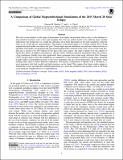Files in this item
A comparison of global magnetofrictional simulations of the 2015 March 20 solar eclipse
Item metadata
| dc.contributor.author | Mackay, Duncan Hendry | |
| dc.contributor.author | Upton, Lisa | |
| dc.date.accessioned | 2022-10-31T15:30:20Z | |
| dc.date.available | 2022-10-31T15:30:20Z | |
| dc.date.issued | 2022-11-01 | |
| dc.identifier | 278735447 | |
| dc.identifier | ce74db09-6135-41dc-b039-5df55dc885fa | |
| dc.identifier | 85141667836 | |
| dc.identifier | 000874268600001 | |
| dc.identifier.citation | Mackay , D H & Upton , L 2022 , ' A comparison of global magnetofrictional simulations of the 2015 March 20 solar eclipse ' , Astrophysical Journal , vol. 939 , no. 1 , 9 . https://doi.org/10.3847/1538-4357/ac94c7 | en |
| dc.identifier.issn | 0004-637X | |
| dc.identifier.other | Jisc: 686445 | |
| dc.identifier.other | Jisc: 686445 | |
| dc.identifier.other | publisher-id: apjac94c7 | |
| dc.identifier.other | manuscript: ac94c7 | |
| dc.identifier.other | other: aas38662 | |
| dc.identifier.other | ORCID: /0000-0001-6065-8531/work/122719663 | |
| dc.identifier.uri | https://hdl.handle.net/10023/26279 | |
| dc.description | Funding: D.H.M. would like to thank the STFC for support via consolidated grant ST/N000609/1 and, the Leverhulme trust, and the ERC under the Synergy Grant: The Whole Sun (grant agreement no. 810218) for financial support. L.A.U. was supported by the NASA Living With a Star program (NNH16ZDA010N-LWS) and by the National Science Foundation Atmospheric and Geospace Sciences Postdoctoral Research Fellowship Program (Award #1624438). | en |
| dc.description.abstract | The solar corona exhibits a wide range of phenomena, from highly non-potential objects such as solar filaments to near-potential structures such as the open magnetic flux. For any global model to be useful in space weather applications, the model must on a single day reproduce all of these phenomena in the same simulation, using the same set of coronal physics and parameters. The purpose of the present paper is to evaluate whether the evolving magnetofrictional model can achieve this goal. Twenty-eight separate simulations are analyzed, where each tries to reproduce both highly non-potential and near-potential phenomena observed in the solar corona on the same day. This day is chosen to be 2015 March 20, the date of the solar eclipse. The study evaluates how the cadence of bipole data, ideal or nonideal coronal physics, and the variety of helicity injection mechanisms affect the accuracy of the simulations. Results show that significantly better agreement arises when using Advective Flux Transport (AFT) synoptic maps to drive the simulations, as compared to 27-day Carrington rotation synoptic maps. Using the nonideal effect of hyperdiffusion leads to the worst agreement with all coronal phenomena. Alternatively, when running either ideal or ohmic diffusion simulations with helicity condensation or bipoles with a self-helicity, a good agreement with both on-disk and limb structures can be found. This suggests that future studies aiming to simulate the corona and reproduce multiple phenomena on a given day should use data products such as AFT and avoid using the nonideal physics of hyperdiffusion. | |
| dc.format.extent | 22 | |
| dc.format.extent | 6647881 | |
| dc.language.iso | eng | |
| dc.relation.ispartof | Astrophysical Journal | en |
| dc.subject | Sun : activity | en |
| dc.subject | Sun: corona | en |
| dc.subject | Sun: evolution | en |
| dc.subject | Sun: filaments, prominences | en |
| dc.subject | Sun: magnetic fields | en |
| dc.subject | QB Astronomy | en |
| dc.subject | QC Physics | en |
| dc.subject | 3rd-DAS | en |
| dc.subject | MCC | en |
| dc.subject.lcc | QB | en |
| dc.subject.lcc | QC | en |
| dc.title | A comparison of global magnetofrictional simulations of the 2015 March 20 solar eclipse | en |
| dc.type | Journal article | en |
| dc.contributor.sponsor | Science & Technology Facilities Council | en |
| dc.contributor.sponsor | Science & Technology Facilities Council | en |
| dc.contributor.sponsor | Science & Technology Facilities Council | en |
| dc.contributor.sponsor | European Research Council | en |
| dc.contributor.institution | University of St Andrews. Applied Mathematics | en |
| dc.identifier.doi | 10.3847/1538-4357/ac94c7 | |
| dc.description.status | Peer reviewed | en |
| dc.identifier.grantnumber | ST/W001195/1 | en |
| dc.identifier.grantnumber | ST/S000402/1 | en |
| dc.identifier.grantnumber | ST/N000609/1 | en |
| dc.identifier.grantnumber | 810218 | en |
This item appears in the following Collection(s)
Items in the St Andrews Research Repository are protected by copyright, with all rights reserved, unless otherwise indicated.

